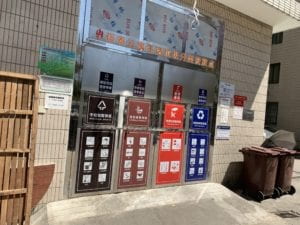Name: Eva Solo
Date: 18/09/19
Professor: Marcela Godoy
I’d like to begin my journal for this week reflecting on the talk we heard from Richard. I was very moved, as every fact thrown my way felt new and unfamiliar. This was the first time I had even consider “trash” to be a valuable material, and after this realisation I began observing the city. Truthfully said, it was like Shanghai transformed, as all I saw now were raw-material collectors on their bikes with the mountains of cardboard, plastic, and styrofoam. I was very curious about my community, and how trash circulates in my neighbourhood so I began my exploration.
First I observed my building: The stairways would be filled with boxed in the evening, yet on my way to school they would be empty. I stared waking up a little bit earlier and peeking out the door to see if I could talk to the collector. On Monday morning I was up and around before 7 am, so I go outside as the night before we left a lot of cardboard boxes outside our door and I was going to bring them down. I met 余 (yu) then, and although there was definitely a language barrier she let me know that any recyclables/raw materials we leave outside the door she will collect, and her /colleague or friend/ sorts out the station outside.
The station outside: On three different days I took the same lap around the neighbourhood. On this route I saw residence bringing sorted and not sorted trash out to the station, yet no one at the station during the majority of the day. The trash holes were locked away and as Richard pointed out, people just left the bags by the side. At around 10:30 I saw a man unlocking the station and turning the lights on to sort trash. I am not sure what his schedule is like but I’ve seen him at the station past 3 am on some weekend nights.
While reading “The Concepts of Sustainability” I felt strongly about two things: 1) Society needs to incorporate sustainable efforts into their daily routine; 2) I’m not sure the first can be executed since we are still trying to define these concepts ourselves, let alone trying to convey them to skeptics. Although it is important to formulate an understanding of the theoretical definition when it comes to sustainability, the practical scenario is well summarised in the quotation “Sustainability, then, is often associated with maintaining Earth’s carrying capacity, usually through alterations of individual and collective human behaviour or through the application of new and developing technologies to minimise the effects of those behaviours” (12). Another emphasis in this section highlights the importance of individual contribution, because through the individual efforts the collective begins to showcase strength, and there is a lot of strength in numbers, especially when discussing our shared Earth. All of these personal efforts would be directing our energy into the planet’s benefit and climbing over self-ego needs to happen before we even attempt to fix all of our already-made destruction. This egoistic perspective I am referencing, is the exact focal point of “Made to be Wasted”. In the current time period, shot-term gain is somehow more valued than longevity which puts our society in a vicious self torture cycle. The current mind-set is ‘how to fix’ but we should also be emphasising prevention rather than creating a problem (which gain finances) and then attempting to fix that problem collectively. The general public is not free to make their own choices, but rather are influenced by the few options that are easily provided to them by the suppliers. Overall, I am much more conscious what I buy and who I support through my financing. I also started looking at packaging in a whole new light, and also limited my taobao shopping if the item can be purchase in a physical store to avoid all of the unnecessary wasted material.

Leave a Reply